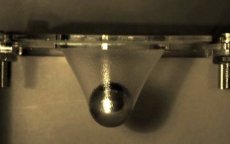Medical expert of the article
New publications
A hydrogel has been created that can replace joints and cartilage
Last reviewed: 01.07.2025

All iLive content is medically reviewed or fact checked to ensure as much factual accuracy as possible.
We have strict sourcing guidelines and only link to reputable media sites, academic research institutions and, whenever possible, medically peer reviewed studies. Note that the numbers in parentheses ([1], [2], etc.) are clickable links to these studies.
If you feel that any of our content is inaccurate, out-of-date, or otherwise questionable, please select it and press Ctrl + Enter.

A group of scientists from Harvard University have managed to create a strong and super-flexible hydrogel that could replace damaged joints or cartilage.
Its creators are specialists in the fields of mechanics, materials science and tissue engineering.
The first hydrogels appeared back in 2003. This is a special type of gelatinous and solid materials. They have found wide application in gardening, medicine and other areas. However, the capabilities of the first hydrogels were quite limited - they became unusable under a small load. All attempts to develop an optimal formula that would provide elasticity and strength ended in failure.
The substance is called hydrogel because of its main component – water. It consists of two polymer networks that interact to produce a very strong effect. Hydrogel is capable of self-healing, very rigid and biocompatible, the latter property making it suitable for medical use.
“Traditional hydrogels are very sensitive to mechanical stress – think of a jelly you can easily dip a spoon into,” explains lead author Jung Yun-sang, a research fellow at the Harvard School of Engineering and Applied Sciences (SEAS). “But because they are biocompatible and water-based, they are used in medicine to grow living tissue and as a nutrient medium. To use hydrogels in new areas of science and industry, it was necessary to eliminate the drawback that made the material unusable due to its low strength. To do this, we replaced one of the polymer networks of the double hydrogel with a network of alginate (obtained from brown algae cells), which is a long chain of hydrocarbons. The result was a hydrogel that remained strong and flexible at the same time.”
The strips of hydrogel created by scientists can withstand mechanical loads 10 times greater than those of previously created materials, they can stretch 20 times better than their analogues, and, thanks to the improved formula, their ability to resist mechanical damage – scratches and cuts – has increased.
According to experts, the improved properties of hydrogels will expand the scope of their application; in particular, these materials can be a good alternative to damaged cartilage and joints, and can also be used in the creation of artificial muscles or serve as a covering for wounds.


 [
[